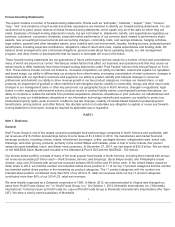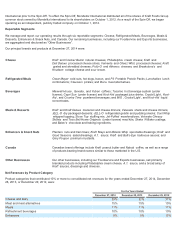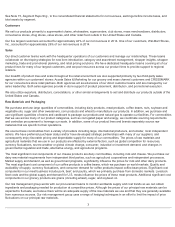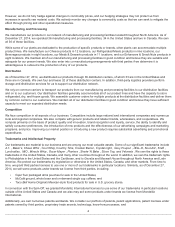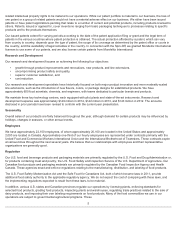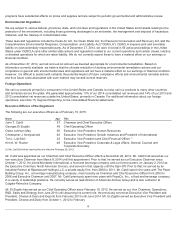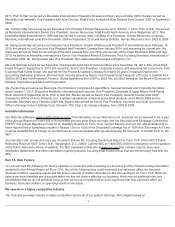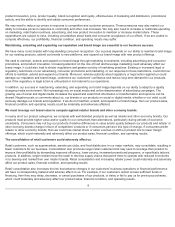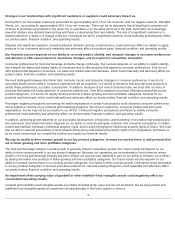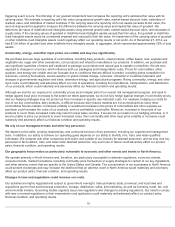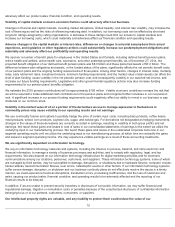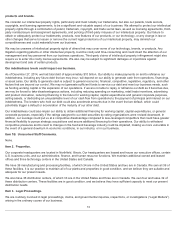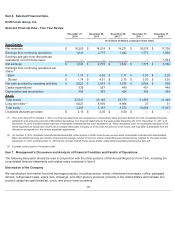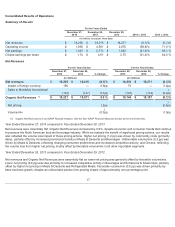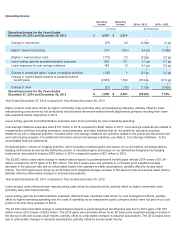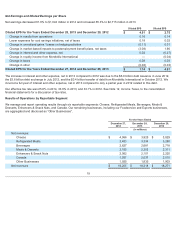Kraft 2014 Annual Report Download - page 14
Download and view the complete annual report
Please find page 14 of the 2014 Kraft annual report below. You can navigate through the pages in the report by either clicking on the pages listed below, or by using the keyword search tool below to find specific information within the annual report.
triggering event occurs. The first step of our goodwill impairment test compares the reporting unit’s estimated fair value with its
carrying value. We estimate a reporting unit’s fair value using planned growth rates, market-based discount rates, estimates of
residual value, and estimates of market multiples. If the carrying value of a reporting unit’s net assets exceeds its fair value, the
second step would be applied to measure the difference between the carrying value and implied fair value of goodwill. We
determine fair value of indefinite-lived intangible assets using planned growth rates, market-based discount rates, and estimates of
royalty rates. If the carrying values of goodwill or indefinite-lived intangible assets exceed their fair value, the goodwill or indefinite-
lived intangible assets would be considered impaired and reduced to their fair value. An impairment of the carrying value of goodwill
or other indefinite-lived intangible assets could negatively affect our operating results or net worth. As of December 27, 2014, we
had $13.6 billion of goodwill and other indefinite-lived intangible assets, in aggregate, which represented approximately 59% of total
assets.
Commodity, energy, and other input prices are volatile and may rise significantly.
We purchase and use large quantities of commodities, including dairy products, meat products, coffee beans, nuts, soybean and
vegetable oils, sugar and other sweeteners, corn products and wheat to manufacture our products. In addition, we purchase and
use significant quantities of resins and cardboard to package our products and natural gas to operate our facilities. We are also
exposed to changes in oil prices, which influence both our packaging and transportation costs. Prices for commodities, other
supplies, and energy are volatile and can fluctuate due to conditions that are difficult to predict, including global competition for
resources, currency fluctuations, severe weather or global climate change, consumer, industrial or investment demand, and
changes in governmental regulation and trade, alternative energy, and agricultural programs. Rising commodity, energy, and other
input costs could materially and adversely affect our cost of operations, including the manufacture, transportation, and distribution
of our products, which could materially and adversely affect our financial condition and operating results.
Although we monitor our exposure to commodity prices as an integral part of our overall risk management program, and seek to
hedge against input price increases to the extent we deem appropriate, we do not fully hedge against changes in commodity prices,
and our hedging strategies may not protect us from increases in specific raw materials costs. For example, hedging our costs for
one of our key commodities, dairy products, is difficult because dairy futures markets are not as developed as many other
commodities futures markets. Continued volatility or sustained increases in the prices of commodities and other supplies we
purchase could increase the costs of our products, and our profitability could suffer. Moreover, increases in the prices of our
products to cover these increased costs may result in lower sales volumes. If we are not successful in our hedging activities, or if
we are unable to price our products to cover increased costs, then commodity and other input price volatility or increases could
materially and adversely affect our financial condition and operating results.
We rely on our management team and other key personnel.
We depend on the skills, working relationships, and continued services of key personnel, including our experienced management
team. In addition, our ability to achieve our operating goals depends on our ability to identify, hire, train, and retain qualified
individuals. We compete with other companies both within and outside of our industry for talented personnel, and we may lose key
personnel or fail to attract, train, and retain other talented personnel. Any such loss or failure could adversely affect our product
sales, financial condition, and operating results.
Our geographic focus makes us particularly vulnerable to economic and other events and trends in North America.
We operate primarily in North America and, therefore, are particularly susceptible to adverse regulations, economic climate,
consumer trends, market fluctuations, including commodity price fluctuations or supply shortages for certain of our key ingredients,
and other adverse events that are specific to the United States and Canada. The concentration of our businesses in North America
could present challenges and may increase the likelihood that an adverse event in North America would materially and adversely
affect our product sales, financial condition, and operating results.
Changes in laws and regulations could increase our costs.
Our activities are highly regulated and subject to government oversight. Various federal, state, provincial, and local laws and
regulations govern food and beverage production, storage, distribution, sales, and marketing, as well as licensing, trade, tax, and
environmental matters. Governing bodies regularly issue new regulations and changes to existing regulations. Our need to comply
with new or revised regulations or their interpretation and application could materially and adversely affect our product sales,
financial condition, and operating results.
10


